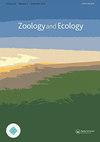2003年巴西巴伊亚南部大西洋热带雨林中卡拉马什和皮门塔的饮食
Q4 Environmental Science
引用次数: 0
摘要
我们研究了巴西巴伊亚州大西洋森林的一块碎片中的一个Chiasmocleis cordeiroi种群的饮食。在一次爆炸性繁殖事件后的晚上,青蛙被收集起来,并被转移到实验室,在那里对它们进行测量、称重,并根据胃冲洗方案取回它们的胃内容物。随后,这些个体被放归被采集的池塘。胃内容物被测量并鉴定到尽可能低的分类水平。在C.cordeiroi的饮食中,最重要的猎物类别是膜翅目(蚁科),正如已经在其他微科中观察到的那样。胃中有大量猎物,生态位振幅低,这表明C.cordeiroi是一位使用主动觅食策略来探测猎物的专家。本文章由计算机程序翻译,如有差异,请以英文原文为准。
Diet of Chiasmocleis cordeiroi Caramaschi and Pimenta, 2003 from the Atlantic Rainforest in southern Bahia, Brazil
We studied the diet of a Chiasmocleis cordeiroi population in a fragment of the Atlantic Forest in the state of Bahia, Brazil. Frogs were collected at night after an explosive breeding event and were transferred to the lab where they were measured, weighed and had their stomach contents retrieved following a stomach flushing protocol. Individuals were later released back into the pond from which they had been collected. Stomach contents were measured and identified to the lowest possible taxonomic level. The most important prey category in the diet of C. cordeiroi was Hymenoptera (Formicidae), as has been already observed for other microhylids. The large number of prey items in the stomach and the low niche amplitude suggest that C. cordeiroi is a specialist using an active foraging strategy to detect its prey.
求助全文
通过发布文献求助,成功后即可免费获取论文全文。
去求助
来源期刊

Zoology and Ecology
Agricultural and Biological Sciences-Animal Science and Zoology
CiteScore
1.00
自引率
0.00%
发文量
1
 求助内容:
求助内容: 应助结果提醒方式:
应助结果提醒方式:


